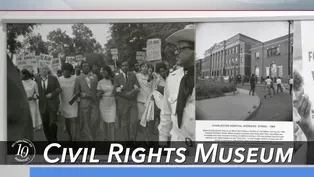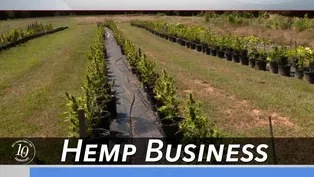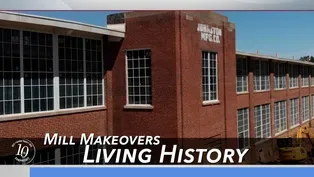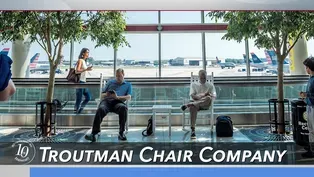
Carolina Impact: October 25, 2022
Season 10 Episode 6 | 26m 43sVideo has Closed Captions
Mill Makeovers 'Living History', Troutman Chair Co., Hemp Business, Civil Rights Museum
Mill Makeovers 'Living History', Troutman Chair Co., Hemp Business, Civil Rights Museum
Problems with Closed Captions? Closed Captioning Feedback
Problems with Closed Captions? Closed Captioning Feedback
Carolina Impact is a local public television program presented by PBS Charlotte

Carolina Impact: October 25, 2022
Season 10 Episode 6 | 26m 43sVideo has Closed Captions
Mill Makeovers 'Living History', Troutman Chair Co., Hemp Business, Civil Rights Museum
Problems with Closed Captions? Closed Captioning Feedback
How to Watch Carolina Impact
Carolina Impact is available to stream on pbs.org and the free PBS App, available on iPhone, Apple TV, Android TV, Android smartphones, Amazon Fire TV, Amazon Fire Tablet, Roku, Samsung Smart TV, and Vizio.
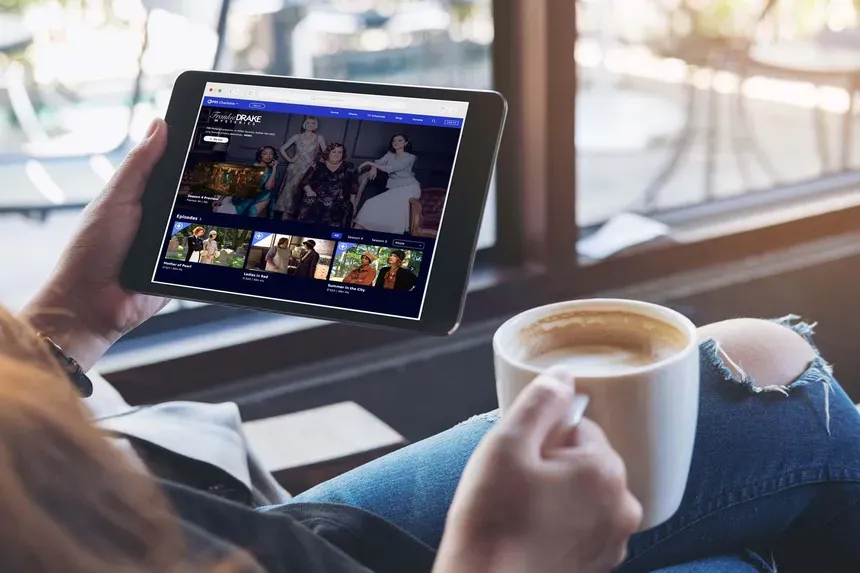
Introducing PBS Charlotte Passport
Now you can stream more of your favorite PBS shows including Masterpiece, NOVA, Nature, Great British Baking Show and many more — online and in the PBS Video app.Providing Support for PBS.org
Learn Moreabout PBS online sponsorship- [Announcer] This is a production of PBS Charlotte.
- Just ahead on "Carolina Impact."
- It's affordable housing that doesn't look affordable.
High quality and low rent in one of Charlotte's most popular neighborhoods.
I'm Jeff Sonier in NoDa with part two of our series on mill makeovers.
- Tucked away in suburban Huntersville is Mecklenburg County's first licensed hemp farm.
We'll take you through the process from harvest to home.
- And we'll find out how those beloved rocking chairs actually ended up at Charlotte Douglas International Airport.
"Carolina Impact" starts right now.
- [Announcer] "Carolina Impact," covering the issues people and places that impact you.
This is "Carolina Impact."
Good evening, thanks so much for joining us.
I'm Amy Burkett.
Charlotte's century-old cotton mills were originally built as places to work and today many are being rebuilt as places to live, but in this economy of rising rents and runaway inflation, can these mill makeovers still be affordable housing?
As part of Carolina Impact's 10 year anniversary, reporter Jeff Sonier and videographer Doug Stacker take us back to a pair of side by side mills in Charlotte's NoDa neighborhood where one developer says the answer to that affordability question is yes.
- Yeah, what people forget about these old cotton mills is that they were once surrounded by Charlotte's original affordable housing, mill villages where the textile workers lived, but here at NoDa, as these cotton mills change and modernize, so do the old mill neighborhoods.
(folksy music) ♪ Oh, oh, tending our cotton ♪ - So we have a wonderful collection of these late 19th, early 20th century commercial mills.
♪ Oh, oh, tending our cotton ♪ They're so big, they're so noticeable.
I mean, they're not only elements of the past, they're elements of the future.
- What Charlotte historian Dan Morrill told us back in 2017 about the old cotton mills of North Charlotte turned out to be a pretty accurate prediction of today.
♪ Tending our cotton ♪ - They just work well, they look well, they market well.
What we're trying to do is to essentially recycle these things.
♪ Tending to our cotton ♪ - [Sonier And back then this was North Charlotte's biggest recycling project, the Old Johnston Mill on North Davidson Street, a dark and damaged dump on the inside, a boarded up and fenced in eyesore on the outside, waiting decades for some sort of mill makeover.
- You were in there, I think you have a good idea what the condition looked like in advance.
- [Sonier] Juan Powell is the regional VP for the community Builders, the non-profit developer that's finally transforming this old mill into 85 modern apartments.
They're even adding a swimming pool, but as they frame in the new halls and walls, they're also keeping Johnston Mill's original arched brick and the hardwood posts cut from old growth tree trunks, creating sort of a hands on museum that you can actually live in.
- We've just done a number of these old historic buildings and we find that they really are part of the fabric and history of a community.
And that's very much the case in Charlotte and in particular in NoDa where it just has a great history of existing historic buildings with a community that's highly inclusive, that's very proud of its history.
- Every day somebody tells me "This is gonna be a cool project when it's done."
- [Sonior] Adam Roy isn't just the construction superintendent here at Johnston Mill, he also lives in NoDa, just a few blocks away.
- Being here about 10 years now, I saw the mill next door get built and this one kind of sitting here, waiting for it to get built.
- [Sonior] And now that it's nearly finished, after two years of construction and reconstruction, Roy walks us through the new Johnston Mill.
- Basically stripped it down, put in new decking, new beams were needed, and then we had shoring post along the whole thing, kind of looked like flying buttresses the way we had it and for it to still be standing even after that, it's kind of cool.
So we're walking into one of the new units that we're putting in.
You come into your galley style kitchen and then into your living space.
- [Sonior] Roy says these apartments have original brick walls that are four bricks thick and windows that are 11 feet high.
- A hundred years ago, this window would've built pane by pane by pane.
- [Sonior] And through the window, well, you can see what else they're building at Johnston Mill.
Right next door, 150 more brand new apartments.
- But the mills were the lynchpin.
They really created the interest and the uniqueness to the site while at the same time creating housing.
It really does produce, you know, quite a win-win situation.
- [Sonier] But here in NoDa, when you create new housing, well what happens to all the old housing?
- And of course if you go up Mercury Street or you go up Alexander Street or you go down Yadkin Street, it's mill houses.
- Or at least it was Mill Houses five years ago.
Today at the corner of Mercury and Alexander, there's a four story apartment complex.
Same story on 36th Street, with block after block of new townhomes replacing these older, smaller homes and more new construction on the way.
How do you balance the growth that a community needs and the problems like gentrification and displacement?
How does a company, you know, try to walk that that fine line between the two?
- For us, that's really key to our mission.
Land prices go up, rents go up, and pretty soon the people who may have been in that community for generations can no longer afford to be there.
- [Sonier] Which is why years before renovating the old Johnston Mill, Powell's company also renovated the old Mecklenburg Mill right next to it, turning this entire mill into 49 units of affordable housing.
The same high ceilings and historic brick walls and tall windows, but here every apartment rents for less than a thousand dollars a month, with many apartments a lot less.
Your rent again is what?
- About 700.
- [Sonier] For a one bedroom?
- For a one bedroom, Yeah.
- [Sonier] Wow, that's just about unheard of in Charlotte, isn't it?
- Yeah, especially this neighborhood.
- [Sonier] Yeah.
Kenneth Holland is a former chef and aspiring artist and for now a valet, parking cars part-time for $14,000 a year.
For him, $700 a month rent means stability versus just surviving.
- You know, you live in a more expensive place and then they raise the rent on you every three years.
You gotta move, you gotta settle, move again.
You just can't quite get it together.
And yeah, walk in here, you definitely would think, "I can't afford this."
You shouldn't have to live in a luxury apartment to live in a neighborhood.
Maybe there should be something else.
- [Sonier] Is this the nicest affordable housing project or complex in Charlotte?
- Yeah, I think so.
- Dehabo Barre's first apartment here at NoDa Mills was this first floor studio, but now she's also in a one bedroom for just over $800 a month.
- It is wonderful.
I'm really fortunate.
Because everything now is so expensive, but knowing that I have that security of a home, it takes a lot of stress off of me.
I'm very happy and very lucky to have made it into this building.
I don't wanna leave.
- And when you combine the high quality, low rent apartments at this mill and 15 more units they're adding at Johnston Mill next door, well that's up to 65 units and that means 65 working class families or individuals with a place to call home, a place they can actually afford.
Amy?
- Thank you, Jeff.
At PBSCharlotte.org, we've got a link to the walks at NoDa Mills where you can find how to qualify for those high quality, low rent apartments.
But just a little FYI, right now the waiting list is at least two years.
Well, since federal regulations lifted preventing farmers from growing hemp for decades, it's quickly become a budding industry in North Carolina.
It's a versatile plant with a wide variety of industrial and retail uses.
Many people confuse hemp with marijuana.
What's the difference and why are hemp products so popular?
Carolina Impact's Rochelle Metzker takes us to a family run farm in Mecklenburg County to learn about the hemp production from harvest to home.
(bluegrass music) - [Metzker] Nestled in the heart of suburban Huntersville, North Carolina is a small veteran owned family run farm called Blackberry Ridge.
- It's kind of a hidden gem, an oasis, so to speak.
We think that's a really special thing that we're able to keep it alive.
- [Metzker] Drive down Beattys Ford Road and look for the roadside farm stand with the large American flag.
No produce here, but you can buy CBD and a bouquet.
Just yards away, fields of hemp and flowers line Blackberry Ridge Farm.
Julia Rogers is the co-founder.
- Look at the pink on that one.
- [Metzger] And this land has been in her family four generations.
Her grandmother, Agnes Barnett, was born and raised here.
- My grandparents had cows.
My dad also maintained the cows after my grandparents passed away.
So I grew up driving a tractor out here.
It's how I learned to drive.
- [Metzger] Blackberry Ridge is small, just 23 acres, tended to by a tight-knit team of four.
They've been working with Mecklenburg Soil and Water Conservation District supervisor Barbara Bleiweis to implement sustainable farming methods.
- They use our conservation practices so they're very much attuned to respecting the earth, respecting the soil and so forth.
They are also a century farm.
Their land has been under family ownership for at least a hundred years.
- [Metzger] The Rogers have expanded into agritourism to stay profitable.
- These are gonna make it so pretty, aren't they?
- Lauren Nelson brought her children for the cut your own flowers experience.
Nelson watches as the kids wander the rows, filling their buckets with colorful blossoms.
- You did so good.
It fills your cup for sure.
- [Julia] Dahlias, lisianthus, sunflowers, xenias, marigolds.
- [Metzger] Just a few of the varieties that grow in the garden.
Julia dreamed of for years, waiting for the right time to revive her family's farm.
(blues guitar) - So these are late plantings.
We do some late plantings in the year.
- [Metzger] As her husband, Army major Nick Rogers, prepared to leave active duty in 2018, he enrolled in a veteran to agriculture transition program at Fort Bragg.
He educated himself on soil science and horticulture.
- They give you kind of a crash course on agro business and just some of the salient details on how to do that the right way.
- [Metzger] He also learned about cannabis, and the growing market for hemp products.
He saw the potential to bring therapeutic relief to retired service members.
- I think we're helping veterans that are no longer in service for sure.
And I just wanna clarify, you know, I still am a reserve service member, so I don't personally use these products unfortunately because it's against the policy.
- Hemp has become a viable crop for many North Carolina farmers, but growing it here wasn't an option before 2017 and in less than five years, North Carolina has gone from zero to nearly 1500 licensed hemp growers across the state.
When the 2018 Farm Bill passed, Rogers jumped at the chance to join the budding CBD industry.
Blackberry Ridge became Mecklenburg County's first licensed hemp farm.
- We grow it, we harvest it, we dry it, we cure it.
We want to extract, but we give it to an extractor and then we get oils back.
- [Metzger] It's easy to confuse hemp and marijuana.
Botanically speaking, they're the same plant species, says farm employee Mason Porter.
- The difference is just the value.
So the THC and the CBD value, you know the cannabis plant that you're used to, that gets you high is gonna be very high THC and low CBD in any other cannabinoids.
Whereas these plants, they've been, you know, genetically grown to produce higher amounts of CBD.
- [Metzger] The Food and Drug Administration is still working to answer questions about the science and effectiveness of CBD and hemp-based products and urges consumers to be wary of companies that market items with unproven medical claims.
Licensed by the USDA, Blackberry Ridge uses seeds from triangle hemp in Durham to grow and harvest between 100 and 200 pounds of cannabis each year.
The CBD is extracted into oil and handcrafted hemp products.
- Being a a very small family farm and making everything in small batches, we get to kind of cater our products to, you know, what people in our community wanna see.
- Kendall Weddington is an employee and also a customer.
- I use it for my back pain.
I have pretty bad upper back knots.
- [Metzger] Boarder's interest in CBD is also personal.
The natural treatments have helped with his mother's fibromyalgia.
For Porter, the biggest reward is when a customer says they're in less pain, thanks to a product he helped make.
- See 'em come here and after a week, it's like breath of fresh air has been breathed into this person.
It almost makes me cry sometimes when I talk to certain customers about this 'cause, you know, it is really life changing.
- [Metzger] For Julia, there's no better way to honor her family's legacy.
- To make it something beautiful for the community, for us to enjoy, for my son to enjoy.
So it's really just an honor.
I feel blessed to have a husband that's willing to do it with me because I know it's not easy.
- [Metzger] Not easy, but it is a labor of love for the Rogers to ensure Blackberry Ridge Farm is around for generations to come.
For "Carolina Impact," I am Rochelle Metzker.
- Thank you Rochelle.
North Carolina Governor Roy Cooper recently signed legislation removing hemp from the State's Controlled Substance Act.
Growers are no longer licensed by the state, as hemp production is now governed at the federal level by the USDA.
With the recent changes, hemp farmers in North Carolina are looking to the future of the CBD industry.
The Rogers continue their focus on educating and engaging the community as they gear up for their fall flower fest at the end of October.
Well, are you as big a fan as I am of the rocking chairs at Charlotte Douglas International Airport?
I often go early to sit in one and listen to the piano player in the center concourse.
It relaxes me before a flight.
It all started 25 years ago with a photography exhibit entitled "Porch Sitting: a Charlotte Regional Family Album."
As props for the photo shoot, rocking chairs were brought into the airport, but when the exhibit left, so did the chairs and that's when the complaints started rolling in.
Carolina Impact's Jason Terzis takes us behind the scenes to one of the region's most popular yet anonymous family owned businesses.
(flight taking off) - [Terzis] Charlotte Douglas International Airport.
The escalator rides, security checkpoints, people in a rush coming and going, but for some time to kill.
- I think we just wanted a place where we could relax.
- [Terzis] If there's one thing CLT is known for, aside from its seemingly never ending construction, is its rocking chairs.
- And the rockers are kind of iconic in the airport.
- I love rocking chairs and I just think that it's awesome.
- I always thought of it as a Charlotte thing.
- [Terzis] From the main terminal to the atrium and points in between, for 25 years, rockers have dotted at the airport, more than a hundred of them.
- I'm a huge fan.
Whenever I'm like in the airport, I try to find one.
I think that travel, air travel at least, is very stressful.
People in airports are very high strung and maybe for good reason, but I think the rocking chair is just a really great message of sit back, have a rock, it'll all be okay.
- There's something soothing about that.
Almost like the lapping of a of waves if you're in a boat.
- [Terzis] Jean Land knows a thing or two about those airport rockers.
After all, it's her company that makes 'em, - I'm proud of them for when they were looking for a chair company, wanted somebody in North Carolina and it's been a lovely relationship.
- [Terzis] You've never rocked on a Troutman Chair Company rocker at the airport, there's a pretty good chance you've done so somewhere else, like the Lake Norman State Park Visitor Center, the Duke Mansion, up in the mountains at Montreat College, the YMCA Blue Ridge in Black Mountain, or the Cone Manor in Blowing Rock.
The Pinehurst Golf Resort also features Troutman rockers and golf legends Arnold Palmer, Jack Nicholas and Gary Player rocked on them at the Masters, and for decades they've been the focal point of the front porch of the famed Grand Hotel on Mackinac Island in Michigan.
- It's just anywhere you go in a public place that has people in rocking chairs just makes us smile.
Cause that's why we do what we do.
- [Terzis] Opening nearly a century ago, the Troutman Chair Company constructed its first chair in 1924.
- And people who worked then loved what they did.
They had great work ethic.
Machines that were made then were made to last forever.
We have some.
(laughs) - [Terzis] And Jean's not kidding.
This behemoth wood surfacer was manufactured in the 1930s.
Made of all cast iron, it's still running on its original motors.
(surfacer buzzing) Just as it did back then, Troutman prides itself on quality.
Everything is made using swelled joint construction, an old technique in which dried oak and hickory are mixed so that pieces will shrink or swell depending on their water content, and that creates a super tight joint.
- All wood starts wet.
So technically, if you really are talking about how long it takes to make a chair, it could be a year and a half to two years, seriously.
- [Terzis] About 20 employees work out of the 40,000 square foot production facility halfway between Troutman and Statesville, and they do everything from start to finish: operating giant saws, belt sanders to soften edges, huge drill was to put holes in rollers and pressing pieces together.
(wood hammering) The finishing room is where they get painted and, once dried, boxed up and shipped out.
- At every point, every single person here is quality control.
There's nobody at the end who's the number one putting a sticker on something.
It's the sprayers, it's the hand sanders, everything's checked multiple times as it goes through the process.
- [Terzis] Perhaps most amazing is they don't use any glue or nails to put their chairs together.
- It definitely impresses me that we still make stuff, make these chairs the same way they were making them a hundred years ago.
- If we put a lifetime warrant down the frame of this chair, and we say that anybody can sit in this chair, it better not break, you know?
And we're confident that it's not because we know what goes into it - [Terzis] The most famous chair Troutman produces is the Kennedy rocker, named in honor of former president John F. Kennedy, who had one in the Oval Office.
- To think that JFK owned over a dozen and rode in one on Air Force One?
That speaks, what more do you say about the chair?
- [Terzis] The P&P Chair Company out of Asheboro made the original Kennedy rocker, but when they ceased operations in 2008, Troutman bought them out and have since continued the Kennedy rocker legacy.
- That is when we learned how important those chairs were to people.
- [Terzis] At Troutman, it's always been about family.
From office Mascot Hank to the Land family, which bought the company in 1999.
Jean's son Cam has been working here since he was 10.
- Jean has asked me many a times if I wanted to run this place, and I haven't given her a definitive answer, but you know, I love coming here.
Like I said, I couldn't imagine working really anywhere else or doing anything else.
- We know when we close that door, at the end of the day, we know that there are people that evening who are gonna go home to their rockers and relax in them or they sat in 'em all day to ease back pain I mean that's pretty humbling, and that just kind of makes it all worthwhile.
- [Terzis] Worthwhile not only for Jean, but for so many others.
For "Carolina Impact", I'm Jason Terzis reporting.
- Thank you Jason.
In Charlotte, you can find Troutman chairs at Blackhawk Hardware in the Park Road Shopping Center and at Firehouse Casual Living.
If you wanna go to Troutman, they have a small showroom in their main headquarters there too.
When you think about the historical locations linked to the civil rights movement, we may think of places like Montgomery or Greensboro.
Did you know South Carolina also played an important role?
in tonight's One Tank Trip, we head to Orangeburg, South Carolina to meet a remarkable man named Cecil Williams who created a civil rights museum to keep that state's contributions alive.
(somber music) - Imagine a time when you can't even go to a restaurant and get a hamburger or you can't go to a school where you would get an adequate education.
You can't even go to a library.
♪ A long time coming, but I know a change gonna come ♪ This is the kind of environment I grew up in.
I am that person that was drinking out the water fountain, to the dismay of my mother who actually chewed me out about doing that.
- It makes you think and wonder how did we really make it?
Because you know, it was a lot of terror going on.
We were aware that there were mean people out there, the Ku Klux Klan and all of that.
- See some things in here like the burning of the cross.
I remember I spent most of my summers here in South Carolina and I remember once going to my aunt's house and the day before they had burnt a cross at the field across at the home that was right across from her, you know, and how scary it was during those times.
This wasn't that long ago.
(chanting) - I started this museum because I felt there was a void, a void in the people, the general public, not only South Carolinians but everyone being able to learn about the great role that South Carolinians played in the Civil Rights movement era.
Often we only know about the bravery of the Reverend Martin Luther King and Rosa Parks, but there were South Carolina heroes who really sacrificed so much to bring about change and we should know their faces.
(soft music) We think that it started right here in South Carolina with that case called Briggs versus Elliot out of Clareton County.
Briggs was the first case in history that attacked segregation in public education and the first of the five cases that became known as Brown versus Board of Education.
- [Speaker] If we don't share what we know, it gets lost and a lot of our history has been lost because we weren't allowed to share.
- There are some events here that you probably won't recognize, such as the Charleston Hospital Worker Strike or the Orangeburg Massacre.
Again, some people out of the state have never even heard of the Orangeburg Massacre 'cause a lot of history has not been told to that great of an extent.
We have approximately 8,000 artifacts, photographs, and documents in the museum at the present time and gaining every day.
You will see some of the businesses that thrive during that time because African Americans weren't welcome in the mainstream businesses.
We had to have our own businesses and certainly we had to have our own schools.
Almost all the photographs in the Cecil Williams South Carolina Civil Rights Museum are by me.
I worked from 18 years old for about 10 years for Jet Magazine.
- So you can see all these pictures and it's like you can touch them and feel them and like all of them are looking at you.
- [Williams] It gives me a great delight to see youngsters speak about their experiences.
It's so important they have something that is really a three dimensional perspective of what our history is about, not just words on paper.
- It's important for us to remember our history because if we don't keep track of it, it might get lost in time.
- My hope for the future is this museum will grow, It's importance will become widespread and people from around the world coming to America and coming to South Carolina and coming near Orangeburg will get to see and experience.
- You can learn more about the Cecil Williams Civil Rights Museum by following the link at our website, pbscharlotte.org.
Well, our region is filled with so many amazing places and people and we need your help to learn about the amazing stories in your backyard.
It could make great features here on "Carolina Impact."
It's easy, just send me an email with the details to stories@wti.org.
Well, that's all the time we have this evening.
We always appreciate your time and look forward to seeing you back here again next time on "Carolina Impact."
Goodnight my friends.
(relaxing music) - [Announcer] A production of PBS Charlotte.
Video has Closed Captions
Clip: S10 Ep6 | 4m 2s | A visit to the Cecil Williams South Carolina Civil Rights Museum (4m 2s)
Video has Closed Captions
Clip: S10 Ep6 | 5m 24s | A look at Blackberry Ridge Farm in Huntersville where they grow flowers and hemp (5m 24s)
Mill Makeovers - 'Living' History'
Video has Closed Captions
Clip: S10 Ep6 | 6m 55s | Creating new apartments in Charlotte's old cotton mills. But is it 'affordable' housing? (6m 55s)
Video has Closed Captions
Clip: S10 Ep6 | 5m 38s | A look at Troutman Chair Co., a local business that's been around for nearly 100 years. (5m 38s)
Providing Support for PBS.org
Learn Moreabout PBS online sponsorshipSupport for PBS provided by:
Carolina Impact is a local public television program presented by PBS Charlotte
